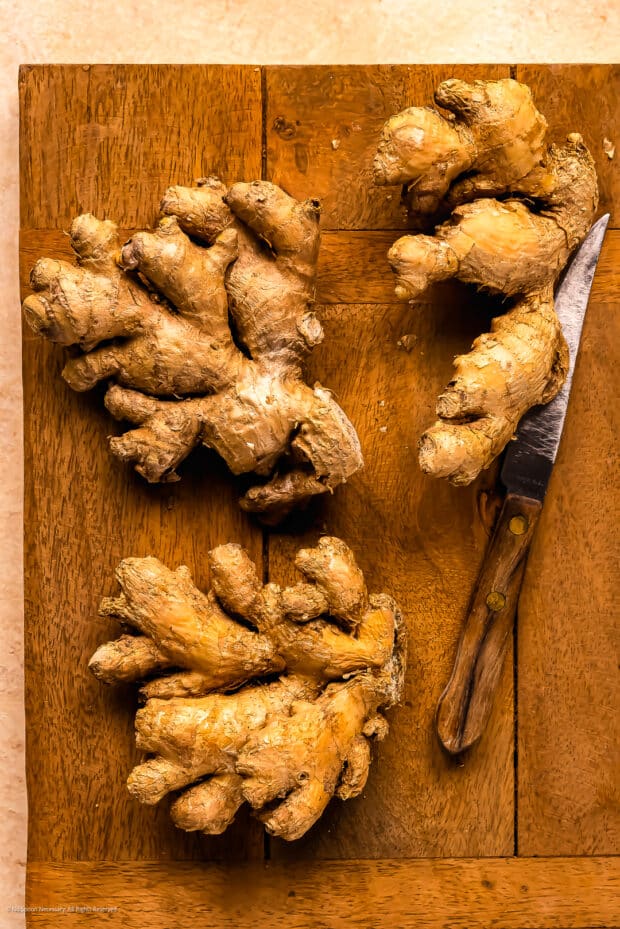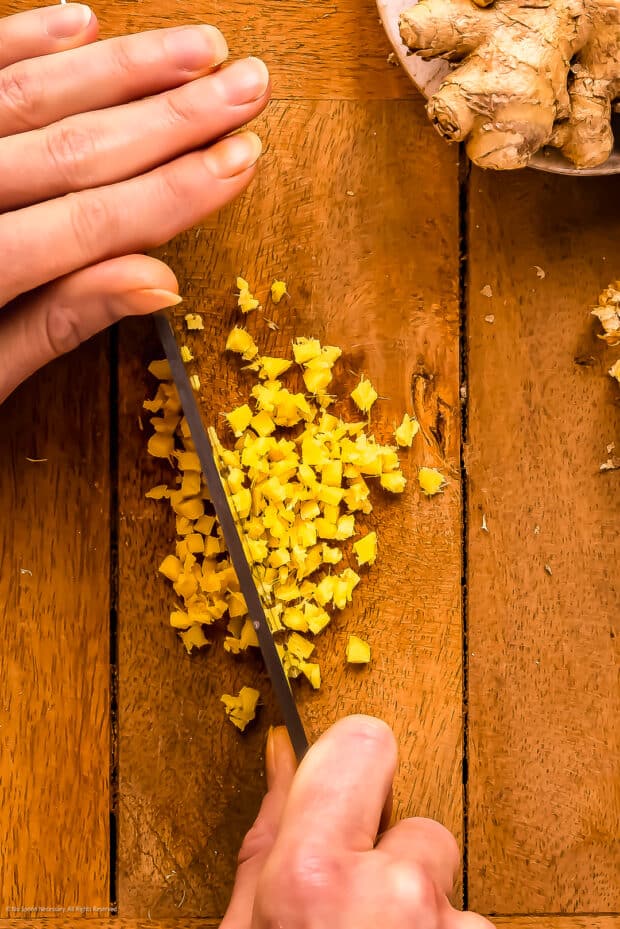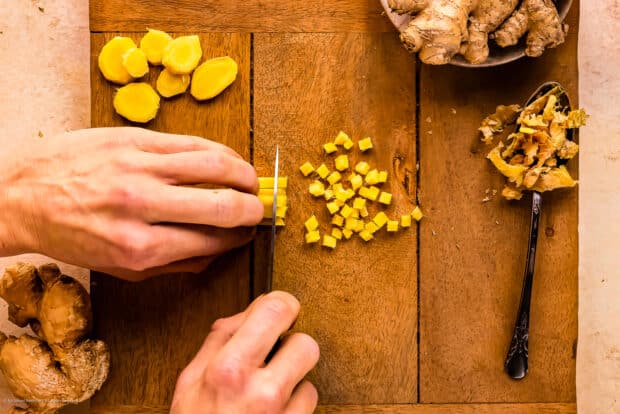This post may include affiliate links. Thank you for your support.
Unlock the magic of ginger and learn all the secrets for peeling, cutting, storing, and using ginger in all its forms: from slicing thin coins and chopping matchsticks to a grated puree. You’ll discover the genius of ginger with this simple guide to preparing and cooking with ginger root like a pro! (step-by-step images included!)
Table of Contents
What is ginger root?
It’s important to know that ginger is not really a root at all. Instead, it’s tropical flowering plant whose rhizome (swollen underground stem) – ginger or ginger root – is used widely as a cooking spice or medicine. Ginger rhizomes grow in sprawling formations which lead to their large, knobby clusters, often marketed as the “hand of ginger”.
You can buy ginger fresh or dried; however, we will be discussing fresh ginger root in this article. Of all the produce items at grocery stores, ginger roots are typically widely available and very easy to find.
What does ginger taste like?
Ginger root is a food wonder and amazing aromatic. Fresh ginger, whether grated, minced, chopped, or sliced, lends a complex and unique zest to dishes.
When it comes to the flavor of ginger, lemon-citrus is the dominating taste with notes of earthy, peppery flavors and a slightly spicy, warm aroma. However, it is important to mention that the flavor and taste of fresh ginger varies greatly depending upon the preparation. For example, fresh ginger is sharp and spicy in taste, but when you cook it, ginger becomes milder and woody in flavor.
You mix ginger with honey and lemon to make a cold-fighting tea. Use grated ginger to flavor stir fries or make delicious gingerbread. Or slice it into coins and candy it. The uses for ginger are truly incredibly versatile.
(Scroll down to learn all about typical spice pairings for fresh and ground ginger.)
Interesting facts about fresh ginger root
Below are some fun facts and helpful little tips you may not know about ginger roots.
- Ginger is very helpful for nausea and sea sickness. In fact, many pregnant women swear by it.
- Fresh ginger is good for detoxing the body when used as a tea.
- Ginger root can help reduce stomach problems – just think of Ginger Ale.
- Fresh ginger is used by doctors as an aid for pain relief and rheumatoid arthritis.
- Ginger is commonly used to aid respiratory problems, coughs, common colds, and even headaches.
- Some physicians even recommend it to helps regulate blood sugar in diabetics.
There’s little doubt as to the benefits of ginger root as countless researcher studies have been done confirming the numerous health benefits over the years.
Buying fresh ginger at the store
Of all the produce, ginger root is one of the simplest to shop for at the grocer. Use the simple tips below when shopping for ginger at the store:
- Select roots that are firm and moist.
- Ginger root should feel heavy for its size.
- Avoid fresh ginger that’s shriveled or dry; however, please note a rough, dry patch where the root was cut is perfectly fine.
- Often, you’ll find roots of ginger displayed at the store as a whole “thumb”. I recommend breaking odd whatever size you need for the recipe in the grocery store. You don’t need to purchase more than you need.
- Young ginger vs. old ginger: There is a difference between young and old ginger. You’ll typically find older ginger at the grocery store, which has a thicker, more papery skin that must be peeled. However, younger ginger has such a thin skin you don’t need to peel the piece of ginger root at all. Unfortunately, most of us will only have access to older ginger roots.
Preparing ginger for cooking – peeling ginger roots
If you’ve just grabbed your first knob of ginger root at the store, you may be intimidated by its gnarly shape and tough, woody skin. However, it’s incredibly quick and easy to safely remove ginger root with a spoon. Simply press the edge of the spoon against the ginger root and use a scrapping motion to remove and discard the skin, revealing the flesh. Or if you prefer, you can use a vegetable peeler instead.
- Note 1: Younger ginger has very thin skin which doesn’t require any peeling at all. However, older ginger, like you typically find at the grocery store, will need to be peeled.
- Tip 2: If you selected older, dried, and shriveled ginger root at the store, you’ll want to use a paring knife instead of a spoon to cut the peel away.
Cutting ginger roots
Below we’ll cover everything you ever wanted to know about how to cut a ginger root. From thin slices to pretty matchstick slices and a paste of grated ginger, this section on cutting roots has got you covered!
How to slice ginger into coins
Ginger is very fibrous, so you need to locate the fibers before slicing the ginger root. To locate the fibers, look at the ginger and locate the fibers which run in the direction of the root of the ginger and its lobes (vertically). Then, use a sharp knife to slice the peeled portion of the ginger root, slicing across the grain of the fibers, into rounds or coins. These rondelle or coins of ginger are perfect for pickling or candying.
Cutting ginger in matchsticks (julienne)
If your recipe calls for julienne, sticks, or slivers ginger, you’ll want to slice the peeled root into rounds using the instructions above. Then, stack two or three rounds of fresh ginger on top of each other. Finally, use your sharp knife to cut the rounds into thin matchsticks.
How to dice or chop a root of ginger
To chop or dice fresh ginger, first slice it into coins and then thin slices (matchsticks) using the methods above. Then, working with a few matchsticks at a time, line the matchsticks up so that they are in a single parallel line. Finally, use your sharp knife to cut the julienne ginger crosswise into a dice or rough chop.
How to mince ginger root
Mincing is to make something virtually unrecognizable, so it’s important to note that a “mince” is much smaller than a “fine dice.”
If you need minced ginger, first peel, slice, julienne, and dice the ginger root using the methods above. Once you’ve chopped the ginger, arrange it into a small pile. Then, arrange the knife so it fits comfortably in your dominant hand and place your free hand on top of the knife. Finally, rock the knife back and forth repeatedly over the pile of chopped ginger root to mince until the ginger is unrecognizable. Occasionally, use the heel of the knife to gather the ginger back into a pile for easy mincing.
How to grate fresh ginger
Turning whole pieces of ginger into a grated paste is like wielding a flavor-packed magic wand in your cooking! Grated ginger is a concentrated burst of warm ginger goodness that’s perfect when you want to infuse your dishes with warming, slightly spicy flavor without any chunky bits of texture.
If your recipe calls for grated ginger, you’ll need to first peel a portion of the root using the spoon method above. Then, hold the piece of ginger firmly in your nondominant hand and the grater in the opposite hand. Press the flat, peeled end of the ginger against the microplane grater and use a back-and-forth motion to grate across the grain of the fibers in the ginger.
Pro-tip: To make super easy work out of grating ginger root, store the whole root (unpeeled) wrapped in plastic in the freezer. When you need grated ginger, peel the portion you need using the instructions above and grate the frozen ginger. Rewrap the ginger root and store it in the freezer again.
Cooking with ginger roots
Now that you know how to peel and cut ginger roots into various cuts and sizes, you’re ready to put all that spicy goodness to use in everything from salad dressings and soups to stir-fries and roasts.
What pairs well with a root of ginger?
Fresh ginger roots are easy to find at the grocery store year-round. Its hot and sour taste pairs excellently with a wide variety of ingredients. Below are some of the best flavor pairings for fresh ginger:
- Apples
- Asian Cuisine: It’s part of an Asian mirepoix with onions and garlic and used in most stir-fries and Asian dishes as an aromatic.
- Basil
- Beverages and Drinks: especially dark rum and teas
- Chicken
- Chile Peppers: especially jalapeños
- Chocolate: especially dark and white chocolates
- Cilantro
- Cinnamon
- Creams and Ice Creams
- Cumin
- Curry and Curries
- Fish, Shellfish, and Seafood
- Garlic
- Honey
- Japanese Cuisine (see Asian cuisine above)
- Lemon
- Lemongrass
- Lime
- Mint
- Molasses
- Pears
- Scallions
- Sesame Oil
- Soups
- Soy Sauce
- Sugar: especially white and brown sugars
- Turmeric
Recipes using fresh ginger
Here are some of my favorite ginger-centric recipes to try:
- Rhubarb Coffee Cake with Candied Ginger
- Carrot and Ginger Soup
- Mango Salad Thai Style
- Thai Steak Noodle Salad
- Cabbage Stir Fried
- Honey Lemon Chicken Bowls with Quinoa
- Apple Cider Meatballs
- How to Poach Chicken Breasts
- Sweet and Spicy Pork Skewers
- Ginger Glazed Pork Chops
- Pear and Ginger Cocktail with Bourbon
- Peach Barbecue Sauce
- Ham Glaze Orange
FAQs: frequently asked questions
Do you need to peel ginger root?
No, not really, however, for aesthetic reasons, you may want to remove the peel. Also, if you’re ginger is old, you’ll want to use a paring knife to cut the dry peel from the root.
What’s the best way to store fresh ginger root?
Refrigerate fresh, whole, un-peeled ginger in an airtight storage bag or plastic wrap in the crisper drawer for up to 2 months. (Or freeze it! Instructions below.)
How to store peeled or cut ginger
If you peeled more ginger root than you need or sliced more than a recipe called for, don’t worry.
- Place the peeled root in plastic wrap or an airtight container and store ginger in the refrigerator for up to 7 days.
- Place any leftover cut, chopped, sliced, minced, and grated ginger in an airtight container or jar in the fridge for up to 7 days.
Can you freeze ginger?
Storing fresh ginger in the freezer is my favorite option. It’s perfect if you don’t cook with ginger that often, but also want to have it on hand.
- To freeze ginger root, wrap it in plastic and then store in the freezer for up to 6 months. Note: You can choose to peel the ginger prior to freezing or leave the peel on.
- You can also freeze minced ginger in ice cube trays. Once the ginger cubes are frozen solid, pop them out of the mold and place them in a freezer-safe storage bag. Frozen ginger cubes will stay good in the freezer for up to 3 months.
- Tip: If you have a large hand of ginger, break it into smaller knobs before storing and freezing.
- Using frozen fresh ginger: Regardless of if you peeled the ginger prior to freezing or not, there’s no need to thaw the ginger if you’re going to be grating it.
With these ginger-prepping powers in your culinary toolbox, you’re all set to cook up some magic and add that unmistakable delicious ginger root flavor to all your favorite dishes. Until next time, friends, happy cooking!
Craving MORE? Follow all the deliciousness on Facebook, Pinterest and Instagram!
More culinary school kitchen tutorials!
- How to peel a peach
- Knife Skills: How to Cut Any Vegetable
- Garlic Cutting Tutorial
- How to Cut an Onion
- Cut Broccoli into Florets
- How to Make Broccoli Rice
How to prep fresh ginger roots 👇

How to Prepare Fresh Ginger Root for Cooking
Equipment
- 1 Clean Cutting Board
- 1 Metal Spoon (for peeling ginger)
- 1 Paring Knife (for slicing, chopping, cutting, and mincing peeled ginger)
- 1 Microplane (for grating peeled ginger root)
Ingredients
- 1 whole, firm Piece of Ginger Root
Instructions
Preparing Ginger Root - Peeling:
- Hold Ginger: Grab a piece of fresh ginger root firmly with your non-dominant hand. And then place a metal spoon firmly in your other hand (dominant hand). (Tip: If your ginger root is knotty, you can make easy work out of peeling by breaking the single lobes off the root and peel those only.)
- Scrape Off Peel: Use the tip or edge of your spoon and carefully scrape the spoon against the ginger to peel off the skin only. Work your way down and around the ginger root, peeling off and discarding only as much skin (peel) as you think you will use. (Tip: When peeling ginger, you want to remove just the skin, if possible.) (Note: Fresh ginger root last longer when stored with the peel on.)
Slicing Ginger into Rounds (Rondelle):
- To Slice Ginger: Ginger is very fibrous, so you want to locate the fibers before slicing the ginger root. To locate the fibers, look at the ginger and locate the fibers which run in the direction of the root of the ginger and its lobes (vertically). Then, use a sharp knife to slice the peeled portion of the ginger root, slicing across the grain of the fibers, into rounds or coins.(Tip: Rondelle or coins of ginger are perfect for candying.)
Cutting Ginger in Matchsticks (Julienne):
- To Julienne Ginger: Peel and slice ginger into rounds using the method above. Next, stack two or three rounds of fresh ginger on top of each other. Then, use your sharp knife to cut the rounds into thin matchsticks. (Tip: If your recipe calls for sticks, slivers of ginger or julienned ginger, this is the method you’ll want to use.)
Dicing and Chopping Ginger:
- To Chop and Dice Ginger: Peel and slice ginger into matchsticks using the methods above. Next, working with a few matchsticks at a time, line the matchsticks up so that they are in a single parallel line. Then, use your sharp knife to cut the julienne ginger crosswise into a dice or rough chop.
Mincing Ginger:
- To Mince Ginger: Peel, slice, julienne, and dice the ginger root using the methods above. Once you’ve chopped the ginger, arrange it into a small pile. Then, arrange the knife so it fits comfortably in your dominant hand and place your free hand on top of the knife. Next, rock the knife back and forth repeatedly over the pile of chopped ginger root to mince until the ginger is unrecognizable. Occasionally, use the heel of the knife to gather the ginger back into a pile for easy mincing. (Note: Mincing is to make something virtually unrecognizable, it’s a much smaller cut than a “fine dice”)
Grating Ginger:
- To Grate Fresh Ginger: Peel the ginger root using the instructions above. Hold the peeled piece of ginger firmly in your non-dominant hand and the grater in the opposite hand. Press the flat end of the piece of ginger against the microplane grater and use a back-and-forth motion to grate across the grain of the fibers in the ginger. (Tip: To make super easy work out of grating ginger root, store the whole root (unpeeled) wrapped in plastic in the freezer. When you need grated ginger, peel the portion you need using the instructions above and grate the frozen ginger. Rewrap the ginger root and store it in the freezer again.)
Storing Ginger Roots
- Use or Store Ginger: For the best flavor, use the prepared ginger root immediately, or within a couple hours of cutting. Store any leftover chopped ginger in an airtight container in the fridge or freezer. (See post for comprehensive storage instructions and options.)
Notes
- Ginger Root: This ginger cutting tutorial works for any size, variety, and number of ginger roots.
- Storage: Please see article for comprehensive storage instructions.
- Kitchen Conversion: A 1-inch piece of raw ginger root with a 1-inch diameter will yield roughly 1 tablespoon of chopped, grated, or minced ginger.
Nutrition
Did you make this recipe?
Mention @nospoonnecessary on Instagram and tag it #nospoonnecessary!
©No Spoon Necessary. All images and content are under copyright protection. Please do not use any images without prior permission. Kindly do not publish this recipe without prior consent. If you want to reference this recipe, please do so by linking directly to this post.
Article references
- Gisslen, W., Griffin, M. E., & Bleu, L. C. (2006). Professional Cooking for Canadian Chefs. John Wiley & Sons.
- America, C. I. O. (2011). The professional chef. John Wiley & Sons.


















